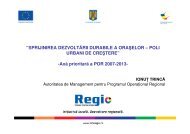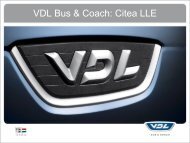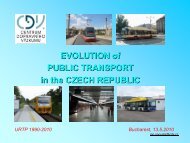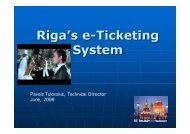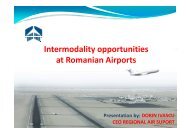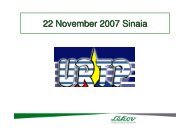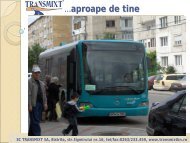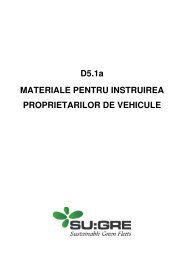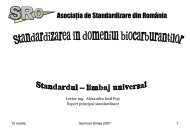The Importance of E-Ticketing to Public Transport in Romania - URTP
The Importance of E-Ticketing to Public Transport in Romania - URTP
The Importance of E-Ticketing to Public Transport in Romania - URTP
Create successful ePaper yourself
Turn your PDF publications into a flip-book with our unique Google optimized e-Paper software.
F<strong>in</strong>anc<strong>in</strong>g Urban <strong>Transport</strong>:<strong>The</strong> <strong>Importance</strong> <strong>of</strong> E-<strong>Ticket<strong>in</strong>g</strong> E<strong>to</strong> <strong>Public</strong><strong>Transport</strong> <strong>in</strong> <strong>Romania</strong>Matthew Jordan-TankPr<strong>in</strong>cipal Urban <strong>Transport</strong> SpecialistEBRD--<strong>URTP</strong> Conference--Sibiu, <strong>Romania</strong>June 19, 2009
EBRD BasicsMandate <strong>to</strong> promote transition <strong>to</strong> marketeconomiesEncourage environmentally sound andsusta<strong>in</strong>able developmentAAA-rated <strong>in</strong>ternational f<strong>in</strong>ancial <strong>in</strong>stitutionfounded <strong>in</strong> 1991, owned by 61 governmentsand two <strong>in</strong>ter-governmental <strong>in</strong>stitutionsEUR 20 billion capital<strong>The</strong> largest lender and private equity<strong>in</strong>ves<strong>to</strong>r <strong>in</strong> Central & Eastern Europe andCIS
Perspectives on Urban <strong>Transport</strong>Sec<strong>to</strong>r <strong>in</strong> EBRD Region
Urban <strong>Transport</strong>’shigh stakes• Estimated 1% <strong>of</strong> <strong>to</strong>talEuropean regional GDPlost <strong>to</strong> urban congestionalone (EU Urban <strong>Transport</strong>Green Paper 2007)• Grow<strong>in</strong>g awareness <strong>of</strong> UT sec<strong>to</strong>r’scontribution <strong>to</strong> Climate ChangeAgenda• Global car emissions projected <strong>to</strong>double from 42 giga<strong>to</strong>nnes CO2 <strong>in</strong>2000 <strong>to</strong> 84 giga<strong>to</strong>nnes CO2 by 2050(Stern Review, 2007)• Emissions from mo<strong>to</strong>rized transportas share <strong>of</strong> <strong>to</strong>tal CO2 emissions <strong>in</strong>cities is estimated <strong>to</strong> be already over40% <strong>in</strong> the Bank’s countries <strong>of</strong>operation• Grow<strong>in</strong>g need for better efficiency <strong>in</strong>UT systems
Major Trends for Urban <strong>Transport</strong> <strong>in</strong> EasternEurope, Russia and CIS countriesMount<strong>in</strong>g challenges– As GDP per capita <strong>in</strong>come moves beyond$5,000 per year, car ownership <strong>in</strong>creasesrapidly (Chamon & Mauro, IMF, 2008)– Car ownership still grow<strong>in</strong>g at 4-6% annually acrossall major cities – will flatten out at 500-600 cars/1000population – we’re only 50% there…– Inverse relationship between growth <strong>in</strong> private carmodal share growth and decl<strong>in</strong>e <strong>of</strong> public transportmodal share -- steady 1-2%/year s<strong>in</strong>ce mid-1990s -when will it stabilize?Unsusta<strong>in</strong>able trend: What city can (or wouldwant <strong>to</strong>) double its road capacity every 10-15years <strong>to</strong> match growth <strong>in</strong> au<strong>to</strong>-kilometers driven?– Negative externalities: Urban air quality andaccidents a grow<strong>in</strong>g concern<strong>Public</strong> Trans %Car %
Given this context, what questions should webe ask<strong>in</strong>g?How can UT systems be made more efficient?How <strong>to</strong> contribute <strong>to</strong> susta<strong>in</strong>able mobility and at the same timef<strong>in</strong>d achievable f<strong>in</strong>anc<strong>in</strong>g structures?What role do market-based <strong>in</strong>struments have? For which type<strong>of</strong> projects?If the private sec<strong>to</strong>r is used, how <strong>to</strong> secure value for money?How <strong>to</strong> foster competitive, commercialized managementapproach vs. ‘old-guard’ public sec<strong>to</strong>r control?How <strong>to</strong> leverage constra<strong>in</strong>ed public budgets most effectively?
EBRD Approach <strong>to</strong>Urban <strong>Transport</strong> Investments NeedsSec<strong>to</strong>r NeedOut-dated <strong>Public</strong> <strong>Transport</strong>systemsEBRD ApproachNew efficient roll<strong>in</strong>g-s<strong>to</strong>ck backed by <strong>Public</strong> ServiceContract (PSC)Track/power supply replacement backed by PSCUrban Road Capacity and/orChronic CongestionVery large CAPEX needs fornew road or PT <strong>in</strong>frastructureInefficient <strong>Public</strong> <strong>Transport</strong><strong>Ticket<strong>in</strong>g</strong>Competitive route tender<strong>in</strong>g with private sec<strong>to</strong>r or“commercialized” public sec<strong>to</strong>r opera<strong>to</strong>rs backed by PSCActive Traffic Management, <strong>in</strong>clud<strong>in</strong>g park<strong>in</strong>gmanagement, based on multi-year performance-basedcontract<strong>in</strong>gNew road and/or rehabilitation based on PerformanceBased Management and Ma<strong>in</strong>tenance <strong>of</strong> Roads (PMMR)Road pric<strong>in</strong>g schemes where appropriatePPP structures where appropriateE-ticket<strong>in</strong>g out-sourced on concession/managementcontract basis <strong>to</strong> private supplier-opera<strong>to</strong>r consortia
Why implement e-ticket<strong>in</strong>g enow?<strong>Public</strong> <strong>Transport</strong> Opera<strong>to</strong>rs feel under-compensated byMunicipalities for transport<strong>in</strong>g social (discounted) passengersMunicipalities/Governments feel uncerta<strong>in</strong> how much <strong>to</strong>compensate PT opera<strong>to</strong>rs because paper or cash-basedticket<strong>in</strong>g systems make accurate statistics on passenger countsvery difficult <strong>to</strong> determ<strong>in</strong>eCash leakage/fare evasion weakens the economics <strong>of</strong> the sec<strong>to</strong>rE-ticket<strong>in</strong>g technology has become ma<strong>in</strong>stream and affordableOpera<strong>to</strong>rs are less creditworthy without e-ticket<strong>in</strong>g s<strong>in</strong>ce banksneed <strong>to</strong> be able <strong>to</strong> model clear and accurate revenues beforemak<strong>in</strong>g loans
EBRD-Favoured Approach: Institutional &contractual arrangements for E-<strong>Ticket<strong>in</strong>g</strong>E Specialist E-ticket<strong>in</strong>g company as“Service Provider”:– Municipality tenders for long-term (6-10 years)service provision contract <strong>to</strong> specialist e-ticket<strong>in</strong>g companies– W<strong>in</strong>n<strong>in</strong>g company f<strong>in</strong>ances up-front costs(approx. EUR 5M for 1 million population city)– Specialist company <strong>in</strong>stalls/operates/ma<strong>in</strong>ta<strong>in</strong>sall system hardware and s<strong>of</strong>tware
lEBRD-Favoured Approach: Institutional &contractual arrangements for E-<strong>Ticket<strong>in</strong>g</strong> E(cont.)Specialist E-ticket<strong>in</strong>g company as “ServiceProvider”:– Company recuperates its <strong>in</strong>vestment and all operationsand ma<strong>in</strong>tenance costs by reta<strong>in</strong><strong>in</strong>g a percentage (5-10%) <strong>of</strong> daily revenues collected through e-ticket<strong>in</strong>gsystem– Company staffs, operates, collects fare revenues, andma<strong>in</strong>ta<strong>in</strong>s new system– City moni<strong>to</strong>rs performance <strong>to</strong> ensure contractualcompliance<strong>The</strong> approach <strong>in</strong>creases revenues per unit significantly byreduc<strong>in</strong>g “cash leakage” & fare evasion by 20-30% whenmov<strong>in</strong>g from co<strong>in</strong> or co<strong>in</strong>-based paper ticket systems <strong>to</strong>electronic collection)
Contractual & Institutional Set-Up forE-<strong>Ticket<strong>in</strong>g</strong> with Service ProviderPassengerspayThroughOn-boardvalida<strong>to</strong>rsMoni<strong>to</strong>rscontract,ensurestransparencyE-ticket<strong>in</strong>gService CoCollectsWeb-based,trackedau<strong>to</strong>matically<strong>in</strong> real-time= Flow <strong>of</strong> MoneyMunicipal<strong>Transport</strong>Dept./AuthorityElectronicPaymentClear<strong>in</strong>ghouseCalculatesdistribution <strong>of</strong>payments <strong>to</strong>accounts<strong>of</strong> all partiesby contractualformulaExternalAuditMa<strong>in</strong> Fund(Bank Account)Opera<strong>to</strong>r(s)1,2,3,…(~93%)E-ticket<strong>in</strong>gService Co(~6%)Bankfiduciary(~0.5%)City<strong>Transport</strong>Dept(~1%)
Contractual mechanics <strong>of</strong> out-sourced model for E-Eticket<strong>in</strong>g systemAn <strong>in</strong>dependent fiduciary agent (bank) receives allrevenues processed through the valida<strong>to</strong>rs.At this stage, the Municipal <strong>Transport</strong> Authority thentells the fiduciary agent (bank) <strong>to</strong> pay the variousopera<strong>to</strong>rs based on their contractually agreed (PSC)operation plans.<strong>The</strong> bank as fiduciary agent first keeps itscontractually determ<strong>in</strong>ed fee (approx. 0.5 percent) <strong>of</strong>the <strong>to</strong>tal revenues, and distributes the rest <strong>of</strong> funds <strong>to</strong>all <strong>in</strong>volved parties.
Revenue verification <strong>of</strong> systemrevenues<strong>The</strong> revenues from each particular valida<strong>to</strong>r term<strong>in</strong>alshould match the electronic records <strong>of</strong> thepassengers enter<strong>in</strong>g the system.<strong>The</strong> electronic records are actually <strong>in</strong>dependentlyverified <strong>in</strong> two locations.<strong>The</strong> electronic data is downloaded <strong>to</strong> ma<strong>in</strong>framecomputers/servers at both the e-ticket<strong>in</strong>g companyand the Municipal <strong>Transport</strong> AuthorityThis sort <strong>of</strong> electronic verification is an effectivemechanism <strong>in</strong> build<strong>in</strong>g the confidence level <strong>of</strong> allparties <strong>in</strong> the fare collection system.
Revenue verification <strong>of</strong> systemrevenuesRevenue Information FlowComputerServer <strong>of</strong> e-ticket<strong>in</strong>gcompanyMounted Valida<strong>to</strong>ron Unit 1Mounted Valida<strong>to</strong>ron Unit 2...Mounted Valida<strong>to</strong>ron Unit nRevenue Information FlowComputer server <strong>of</strong> Muni<strong>Transport</strong> Authority
Basic example: Estimate for medium-sized <strong>Romania</strong>n CityIN LEIBASIC PARAMETERS OF PUBLIC TRANSPORT OPERATIONSFLEET SIZEANNUAL PASSENGERSANNUAL SYSTEM REVENUES(ANNUAL VALUE LOST DUE TO FARE EVASION & CASH LEAKAGE)NUMBER OF STAFF EMPLOYED BY OPERATOR IN TICKETING SYSTEM(TICKET SALES AND TICKETING CONTROLS)COST OF RUNNING OLD SYSTEMUP-FRONT INVESTMENT COST OF NEW E-TICKETING SYSTEM FOR(VALIDATORS, COMMUNICATIONS, SOFTWARE, HARDWARE)ANNUAL VALUE OF FEE CHARGED BY E-TICKETING COMPANY(EXAMPLE OF 6% OF ALL SYSTEM REVENUES) -- i.e., COST OF NEWSYSTEM TO PUBLIC TRANSPORT OPERATORANNUAL VALUE OF FEE CHARGED BY FIDUCIARY AGENT (BANK)(0.5%)ANNUAL AMOUNT TRANSFERRED TO MUNICIPAL TRASNPORT DEPT.(OPTIONAL, 1%)ANNUAL BENEFIT OF NEW E-TICKETING SYSTEM TO PUBLICTRANSPORT OPERATOR (NEW REVENUE + SAVINGS FROMELIMINATING INTERNAL COST OF RUNNING OLD SYSTEM - 6% FEETO E-TICKETING CO. - 0.5% TO FIDUCIARY AGENT - 1% TO CITY)CURRENTSITUATIONWITH BASICTICKETINGSYSTEM25050,000,00040,000,00010,000,0001502,160,000SITUATIONWITH E-TICKETINGSYSTEM25050,000,00050,000,00000010,000,0003,000,000250,000500,0008,410,000
Audit<strong>in</strong>g the systemExternal audit<strong>in</strong>g will be done regularly and atrandom.<strong>The</strong> selected audi<strong>to</strong>r cannot have any contractual orcommercial ties <strong>to</strong> any <strong>of</strong> the parties <strong>in</strong>volved <strong>in</strong> thenew ticket<strong>in</strong>g system, <strong>in</strong>clud<strong>in</strong>g with the bank, themunicipality, or opera<strong>to</strong>r(s)
E-ticket<strong>in</strong>g system should be multi-functional, multi-sec<strong>to</strong>ralSmart cards used across all public transportmodes, and city park<strong>in</strong>g services – an importantsystem <strong>in</strong>tegra<strong>to</strong>rIn Hong Kong, the Oc<strong>to</strong>pus card permits users <strong>to</strong>make purchases at shops as well as pay for publictransport and park<strong>in</strong>g, by allow<strong>in</strong>g up <strong>to</strong> US$125equivalent <strong>of</strong> s<strong>to</strong>red value <strong>to</strong> be placed on the cardOutside payment applications <strong>in</strong>cludesupermarkets, convenience s<strong>to</strong>res, fast foodfranchises, vend<strong>in</strong>g mach<strong>in</strong>es, pho<strong>to</strong>copiers,c<strong>in</strong>emas, and sports venues
EBRD’s s role <strong>in</strong> the new e-ticket<strong>in</strong>g esystemsProvid<strong>in</strong>g Technical Assistance <strong>to</strong> cities withsett<strong>in</strong>g up <strong>in</strong>stitutional framework, division <strong>of</strong>roles between opera<strong>to</strong>rs and e-ticket<strong>in</strong>gcompany (e.g., who does ticket<strong>in</strong>g control?),technical specifications <strong>of</strong> new system, andtender documentationOnce the e-ticket<strong>in</strong>g company has beenselected, EBRD can f<strong>in</strong>ance the up-front<strong>in</strong>vestment <strong>of</strong> the new system
A few part<strong>in</strong>g comments on lend<strong>in</strong>g <strong>to</strong> the urbantransport systems <strong>in</strong> current environment(Dedicated & Secure) Cash (Flow) is K<strong>in</strong>g:– PSC/e-ticket<strong>in</strong>g/tariff reforms help guaranteesusta<strong>in</strong>ability and self-f<strong>in</strong>anc<strong>in</strong>g <strong>of</strong> transport companies– EBRD can consider easier access <strong>to</strong> f<strong>in</strong>ance forcompanies/cities if reforms like e-ticket<strong>in</strong>g, PSCs, andcorporate governance measures are implemented thusreduc<strong>in</strong>g f<strong>in</strong>al burden on municipal f<strong>in</strong>ances
THANK YOUContact details:Matthew Jordan-TankEuropean Bank for Reconstruction and DevelopmentLondon Headquartersjordantm@ebrd.com+44 020 7338 6000
www.ebrd.com



